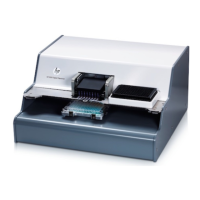
Do you have a question about the HP D300 and is the answer not in the manual?
Details hardware, software, and environmental conditions required for the HP D300 Digital Dispenser operation.
Outlines essential safety practices for operating the dispenser, including placement, power, and avoiding moving parts.
Specifies recommended PPE for fluid handling operations, matching company safety standards.
Addresses potential aerosol generation and recommends using exhaust enclosures for hazardous fluids.
Warns about pinch points between dispenser components and advises safe handling to avoid injury.
Explains Class 1 laser safety compliance and warnings for the destination plate height sensor.
Covers electrical safety certifications, voltage, amperage, and fuse specifications for the dispenser.
Details FCC/EMC compliance for emissions and potential radio frequency interference.
Explains requirements for cleaning and decontamination before shipping the dispenser for service.
Provides guidance on proper disposal procedures for used dispensehead cassettes and pipette tips.
Offers recommendations for workstation setup to minimize ergonomic risks during dispenser operation.
Directs users to Tecan Service Help Desk for further support and assistance.
Step-by-step guide to unpacking, connecting, powering on, and installing software for the dispenser.
Introduces the main operating window, software startup routines, and basic interface elements.
Explains how to load pre-saved plate configurations (.xls files) into the software for dispense operations.
Overview of the Options dialog box and its various panes for customizing software settings and dispenser behavior.
Details the steps involved in executing a plate dispense operation, from initiation to completion.
Instructions for loading and verifying the destination well plate on the dispenser's plate holder.
Guide on how to properly load a new Dispensehead Cassette into the instrument.
Explains the process of filling Dispenseheads with fluids using the Load Fluid dialog box.
Describes how to access and view dispense operation reports generated by the software.
Provides instructions for safely shutting down the dispenser and closing the software.
Guides users on defining fluids, source plates, wells, and concentrations in the software's fluids table.
Details methods for editing, copying, pasting, and managing fluids within the software's Fluids List.
Explains how to add fluids to wells, set titrations, and manage the well plate image.
Describes how to assign specific concentrations or volumes to selected wells for dispensing.
Guides on replicating plate designs and mapping fluids using the Paste Special function for efficiency.
Explains how to program DMSO normalization for wells to ensure consistent assay volumes.
Describes how to randomly reorder wells to minimize systematic plate edge effects on output data.
Instructions for saving the current plate design as an Excel file for future use and editing.
Introduces the Plate Layout Wizard for creating simple and complex plate designs efficiently.
Details how to position NoDispense fluids (blanks or controls) within the well plate using the Wizard.
Explains how to position single zone titrations within the well plate layout using the Wizard.
Covers advanced plate design configurations using the Wizard for complex assays.
Guides on creating titrations with unevenly spaced concentrations for specific assay regions.
Explains how to adjust the dynamic range of titrations by modifying fluid concentrations.
Details how to create layouts with two fluids per well for drug-drug interaction studies.
Provides general troubleshooting steps for software, computer, stage, and fuse issues.
Lists common error messages and their recommended actions for resolution.
Describes the global view of the plate showing all dispensed fluids, regardless of editing status.
Explains the purpose and functionality of the Plate Layout Wizard for creating plate configurations.
Covers software interaction basics like closing windows, using buttons, and shortcut keys.